|
5C Program News - 2013: Year in Review
The 5C Enews is funded through the Fisheries Restoration Grant Program of the CA Department of Fish and Wildlife.
In this issue:
Water Conservation, Climate Change and Drought
5C has been involved in water conservation for years, but those efforts have never been more timely than now as we enter the worst drought in California history. To help form your own drought-survival strategy, visit our new Water Conservation Page for simple, inexpensive ideas on how to conserve every precious drop. The page also lists several web-based resources for additional information.
Climate Change & Drought: Weaverville is unique in California as a location where weather data has been recorded continuously since 1850. 5C Program Director Mark Lancaster studies this data and speaks in Northern California on what this means to area residents and wildlife. (Hear his 1/14/14 interview on KMUD). The chart below dramatically illustrates how 2013 rainfall amounts measure up to an average year and the most recent years. As the drought continues into 2014, water sources will be strained to produce adequate quantities for all the users. Water conservation will be a key part of Northern California’s strategy to accommodate the expected shortage.
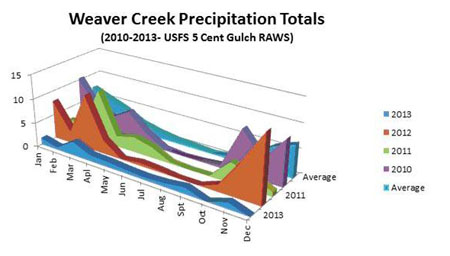
Visit our Water Conservation Page for more information and water-saving tips.
Water Conservation - Rooftop Rainwater Catchment Project
Rooftop Rain Catchment is an effective strategy to reduce impacts on surface water, is already in use at private properties in Trinity County and is demonstrated at the 5C Water Conservation trailer. 5C plans up to five rainwater catchment demonstration projects to be installed in Weaverville at public facilities to provide effective rainwater capture, water use, and public demonstration and outreach. The goal is to increase awareness of the potential and benefits of these systems.
The demonstration projects will save approximately 160,000 gallons of water during June through September, the critical low flow summer period. Water savings are the result of water captured from planned rooftop rainwater collection systems and the distribution and installation of low flow shower heads to residents that participate in the conservation workshops and trainings as well. The project will also teach techniques landowners can use to reduce summer water demand, increase awareness of timing of watering operations on stream flows, improve storm water metering (with the use of bio swales at parking lots, rainwater storage from rooftops, and use of grass and non-paved surfaces to absorb and delay surface runoff rates), as well as other conservation techniques that could result in greater water savings.
In addition to the sites selected (listed below), the 5C Program will work with homeowners to demonstrate smaller scale rain barrel collection systems. At least one landowner has committed to installing and demonstrating rain barrel stormwater collection in conjunction with the education and outreach efforts of this proposal.
The locations selected as Rooftop Rainwater Catchment Demonstration Sites are:
 Young Family Ranch: The Young Family Ranch is owned by the Trinity Foundation and managed and maintained by the Trinity County RCD. The facilities provide environmental educational events and summer youth camps. The location has a suitably large roof area and a shed roof will be connected to the ranch house to increase runoff. The TCRCD has decided to upgrade gutters as part of the project. They have also decided to use a two stage process where water is collected and stored in tanks below the ranch house and then pumped up to tanks at the highest point on the property. From this location gravity water can support all of the gardens on the property as well as the lawn and fruit trees. Young Family Ranch: The Young Family Ranch is owned by the Trinity Foundation and managed and maintained by the Trinity County RCD. The facilities provide environmental educational events and summer youth camps. The location has a suitably large roof area and a shed roof will be connected to the ranch house to increase runoff. The TCRCD has decided to upgrade gutters as part of the project. They have also decided to use a two stage process where water is collected and stored in tanks below the ranch house and then pumped up to tanks at the highest point on the property. From this location gravity water can support all of the gardens on the property as well as the lawn and fruit trees.
Stats:Roof Area: 853 sq ft, Annual H20:15,950 Gallons, Summer H20: 1,484 Gallons, Storage Capacity Size: 15,000 Gallons
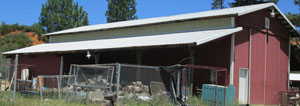 Trinity High School Future Farmers of America ( FFA) Barn: The Trinity High School Agriculture Program provides shelter and farm opportunities for high school students raising livestock as part of their FFA program. The barn houses FFA animals year-round and provides an excellent educational opportunity for high school students with an interest in agriculture. The location is prone to storm-water sediment transport and the catchment would also provide some reduction in water flow during winter storms. Rain water captured off of the barn will be used during the summer for washing livestock, cooling them, and cleaning pens, tools and boots. The combination of roof area and water usage in a vocational education setting is highly effective and can be combined with classroom conservation trainings. Trinity High School Future Farmers of America ( FFA) Barn: The Trinity High School Agriculture Program provides shelter and farm opportunities for high school students raising livestock as part of their FFA program. The barn houses FFA animals year-round and provides an excellent educational opportunity for high school students with an interest in agriculture. The location is prone to storm-water sediment transport and the catchment would also provide some reduction in water flow during winter storms. Rain water captured off of the barn will be used during the summer for washing livestock, cooling them, and cleaning pens, tools and boots. The combination of roof area and water usage in a vocational education setting is highly effective and can be combined with classroom conservation trainings.
THS Barn Stats: Roof Area: 2,400 sq ft,Annual H2O: 44,862 Gallons,Summer H2O: 4,174 Gallons, Storage Capacity: 5,000 Gallons
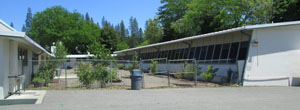 Weaverville Elementary School Garden: Weaverville Elementary has operated a student garden for more than a decade and provides a setting that combines positive aspects of classroom exposure, large roof area, and a vegetable garden for water use. Surrounded by classrooms and metal roofs, the location is ideal for water conservation education. In addition, the project can show case larger scale roof potential while integrating conservation education in the science curriculum of 6th-8th grades. Weaverville Elementary School Garden: Weaverville Elementary has operated a student garden for more than a decade and provides a setting that combines positive aspects of classroom exposure, large roof area, and a vegetable garden for water use. Surrounded by classrooms and metal roofs, the location is ideal for water conservation education. In addition, the project can show case larger scale roof potential while integrating conservation education in the science curriculum of 6th-8th grades.
Stats: Roof Area: 5,210 sq ft, Annual H2O: 95,707 Gallons, Summer H2O: 8,904 Gallons, Storage Capacity: 10,000 Gallons
Golden Age Center: The Golden Age Center is a non-profit senior citizen resource center that provides lunches, transportation, social activities and other resources to community members. The site provides a location where people will be able to see the benefits of gardening with rain water.
Stats: Roof Area: 3,240 sq ft, Annual H2O: 60,564 gal, Summer H2O: 5,635 gal, Storage Capacity: 10,000 Gallons
Trinity Performing Arts Center: The Trinity Alps Performing Arts Center is a non-profit that provides facilities for music and theatrical productions as well as host Community Theater. The facility is at a very visible location with a large metal roof that provides a substantial surface area for catching rainwater.
Stats: Roof Area: 10,800 sq ft, Annual H20: 201,881 gal, Summer H2O: 18,782, Storage Capacity: 20,000 Gallons
In addition to the sites selected, the 5C Program will work with homeowners to demonstrate smaller scale rain barrel collection systems. At least one landowner has committed to installing and demonstrating rain barrel stormwater collection in conjunction with 5C education and outreach efforts.
Workshops & Public Education
The 5C Fish Passage Design & Engineering Workshop was held Feb 6-8, 2013 in Ukiah, CA. The workshop consisted of two days of classroom learning and one day of hands-on field work. A panel of instructors including Michael Love, Kozmo Bates & Ross Taylor focused on design and implementation for addressing fish migration barriers and sedimentation sources. The workshop was well attended by engineers, hydrologists, biologists, environmental planners, and other staff involved in the design and implementation of fish passage projects.
The 5C Beaver Management Workshop was held on Saturday February 9, 2013 at the Douglas City Volunteer Fire Department. Mike Callahan of Beaver Solutions and Bob Schaefer of CA Department of Fish & Wildlife presented on beaver history, habitat, behavior, and challenges associated with beaver activity and man made infrastructure. The group toured a nearby site with recent beaver activity and discussed solutions for protecting culverts, roads, trees, and private property.
The 5C was pleased to help sponsor the Salmon Restoration Foundation’s 31st Annual Salmonid Restoration Conference held March 13-16 in Fortuna, CA. In addition, 5C Program Director Mark Lancaster led a session at the conference.
The 5C Water Conservation & Catchment Workshop held March 23, 2013 featured a presentation given by Bruce Hallinan on the benefits of rainwater catchment systems and native plant landscaping. 5C provided informative brochures on water conservation and samples of water-saving devices & techniques.
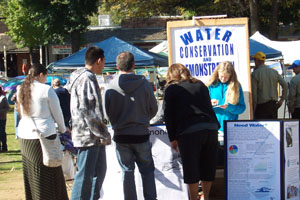 The 5C Water Conservation Demonstration Trailer was completed to provide opportunities for public education and observation of water saving devices. This public outreach opportunity informed participants at numerous public events, including the Trinity County Fair, Weaverville 4th of July Parade, Weaverville Farmer’s Market and the Salmon Festival. The trailer demonstrated rooftop rainwater catchment, low-flow showerheads, water efficient plumbing devices, and alternative landscape designs. Pamphlets and brochures with specific rainfall data, rooftop calculations, native plants species, and household water use were also distributed. Overall, an estimated 10,000 people observed water saving devices and techniques during displays in 2013. With California’s worst recorded drought in progress, the message was timely and well received. The 5C Water Conservation Demonstration Trailer was completed to provide opportunities for public education and observation of water saving devices. This public outreach opportunity informed participants at numerous public events, including the Trinity County Fair, Weaverville 4th of July Parade, Weaverville Farmer’s Market and the Salmon Festival. The trailer demonstrated rooftop rainwater catchment, low-flow showerheads, water efficient plumbing devices, and alternative landscape designs. Pamphlets and brochures with specific rainfall data, rooftop calculations, native plants species, and household water use were also distributed. Overall, an estimated 10,000 people observed water saving devices and techniques during displays in 2013. With California’s worst recorded drought in progress, the message was timely and well received.
If you would like to have the 5C water conservation team and demonstration trailer at your event, contact 5C at 530.623.3967x111 to schedule a presentation.
Awards & Recognition
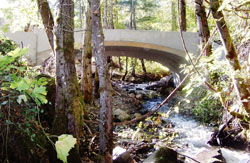 The Conner Creek Fish Passage Improvement Project received Honorable Mention as a "Distinguished Project in Fisheries Engineering and Ecohydrology" by the American Fisheries Society during the 2013 International Conference on Engineering & Ecohydrology for Fish Passage in Corvallis, Oregon on June 26, 2013. The AFS recognition was presented to the Forest Service for their support of the project. The Conner Creek Fish Passage Improvement Project received Honorable Mention as a "Distinguished Project in Fisheries Engineering and Ecohydrology" by the American Fisheries Society during the 2013 International Conference on Engineering & Ecohydrology for Fish Passage in Corvallis, Oregon on June 26, 2013. The AFS recognition was presented to the Forest Service for their support of the project.
Previously, the National Fish Habitat Partnership selected Conner Creek as a 2012 top ten Waters to Watch in the United States. This award, assembled by the nation’s leading authorities on aquatic conservation, lists rivers, streams and shores that will be healthier habitats for the fish, wildlife and people who call them home. Read more about this recognition at the NFHP website.
Recent & Upcoming Migration Barrier Projects
Featured fish passage enhancement projects by 5C member Counties collectively average 5.1 barrier removal projects per year with annual spending of approximately $1.5 million for construction, supplies and materials, which supports local economies.
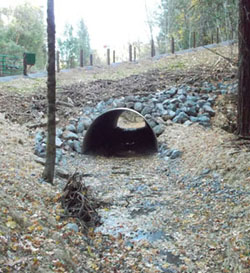 Ryan Creek FPIP in Mendocino County completed. This project restored access to high quality spawning and rearing habitat and restored fairly natural hydraulic function and watershed processes in an important coastal watershed for the federally listed species. Before removal in 2013, the 5’ metal culvert on Ryan Creek at a private driveway effectively blocked access to approximately 1.34 miles of anadromous fishery habitat. The 5’ metal culvert with an approximate 1.5’ jump was replaced with a 14’ x 12’ multi-plate arch. The project restored access to high quality spawning and rearing habitat and restored fairly natural hydraulic function and watershed processes to 1 1/3 mile of Ryan Creek. Combined with Ryan #1, the project restores 2.8 miles of habitat.
Read more about this project on our Mendocino News Page Ryan Creek FPIP in Mendocino County completed. This project restored access to high quality spawning and rearing habitat and restored fairly natural hydraulic function and watershed processes in an important coastal watershed for the federally listed species. Before removal in 2013, the 5’ metal culvert on Ryan Creek at a private driveway effectively blocked access to approximately 1.34 miles of anadromous fishery habitat. The 5’ metal culvert with an approximate 1.5’ jump was replaced with a 14’ x 12’ multi-plate arch. The project restored access to high quality spawning and rearing habitat and restored fairly natural hydraulic function and watershed processes to 1 1/3 mile of Ryan Creek. Combined with Ryan #1, the project restores 2.8 miles of habitat.
Read more about this project on our Mendocino News Page- Summit Creek, Trinity County completed. A partnership between 5C & Trinity County DOT to improve water quality in Summit Creek by reducing sediment into the stream, improving year round access for residents, and increasing public safety for those crossing the stream during high flows. By providing a culvert sized to handle the anticipated 100-year flows, vehicles will no longer discharge pollutants, compact the streambed and potentially crush aquatic species. Embedding the culvert in material designed to simulate the streambed prevents scour and provide safe passage for all life stages of salmonids that may be present.
New For 2014:
- Upper Sidney Gulch at Weaver Bally Loop Road in progress. The project will provide for passage of all life stages and species of salmonids and rainbow trout. The estimated habitat gain is 1.2 miles of perennial stream spawning and/or rearing habitat. The current design is to replace the existing undersized culvert with a twelve foot wide embedded box culvert to restore natural stream function.
- Sharber-Peckham Creek FPIP in progress. will replace an under-sized culvert preventing migration of spawning adults to allow use of approximately 1.2 miles of high quality spawning, over-wintering and summer rearing habitat within this tributary to the Trinity River.
Road Drainage and Sediment Reduction Projects
2013 was a productive year for reducing sources of sediment into creeks and rivers in Trinity and Del Norte Counties. A brief list of completed projects includes:
- Griffin Creek at Oregon Mountain Road (Del Norte) completed replaced an undersized, failed culvert with a larger culvert with natural stream-bed bottom to enhance fish habitat, increase traveler safety and eliminate the potential for 3,660 cubic yards of sediment from this tributary to the Middle Smith River.
- Patricks Creek Road Sediment Reduction and Road (Del Norte) completed Improvement project provided paving and installation of culverts to eliminate the potential of 2,700 cubic yards of sediment from this tributary to the Smith River.
- Within the Smith River National Recreation Area in Del Norte County completed 4 projects were implemented with regrading and paving to reduce sediments washed into nearby streams and prevents pollution caused by dust in dry seasons. The projects are: French Hill Road, Old Gasquet Road, Holiday Mine Road and Major Moore/Low Divide.
- Browns Creek Road Project in progress used regrading and road treatments to reduce sediments on private roads near Browns Creek, an important tributary to the Trinity River.
- Trinity River/Dutch Creek Road Sediment Reduction, Trinity County complete. Designed to enhance water quality, improve salmonid habitat, and reduce road maintenance costs for the Trinity County Department of Transportation (TCDOT) by implementing cost-effective sediment reduction treatments at County road-related sediment source sites on Dutch Creek Road. This project eliminates the potential for 2,800 cubic Yards of sediment from the Trinity River
Fisheries Monitoring and Project Design
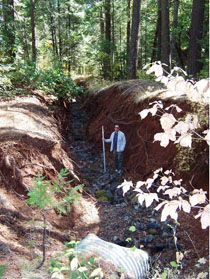 Ryan Creek Project Montoring As work was completed on Ryan Creek #2 project, monitoring began to determine the success of the project. Monitors and local residents were delighted to report that fish are now to be found in the upper reaches of the creek, an area where no fish have been seen for 50 years. Ryan Creek Project Montoring As work was completed on Ryan Creek #2 project, monitoring began to determine the success of the project. Monitors and local residents were delighted to report that fish are now to be found in the upper reaches of the creek, an area where no fish have been seen for 50 years.- Sidney Gulch at USFS Weaverville Compound Study in progress project will conduct a study and planning to explore removal of a concrete channel that prevents fish passage.
- Conner Creek Mouth Feasibility Study in progress Restore channel connectivity at the original channel and modify or eliminate diversion tunnel installed to divert the creek to mine the channel bottom. Steelhead occupy Conner Creek and fish can move into Conner Creek from the Trinity River on limited ideal migration flows, but much of the time access is limited by the channel diversion near the mouth of the creek. This project will do a feasibility study to determine if the channel can be modified to restore natural flows and increase fish passage opportunities.
- Schofield Gulch Planning East Weaver Creek is the primary drinking water source for the community of Weaverville and an important fisheries stream, supporting resident trout as well as Chinook and coho salmon, and steelhead trout downstream. Treatment of the site will prevent approximately 2,000-3,000 yd3 of sediment from entering East Weaver Creek in the future. The project will benefit downstream fisheries to the Trinity River as well as community drinking water.
Download past issues of 5C News:
5C in the News:
- 2/4/14, The Independent - North Coast Water Conservation Workshop held in Briceland Feb1-2, 2014. 5C Director Mark Lancaster speaks on climate change & water conservation tips.
- 1/22/14, Trinity Journal - Reducing sediments in streams, Browns Creek Project
- 1/14/14. KMUD Radio - Discussion with Mark Lancaster regarding rainwater catchment, reducing use of surface water
- 10/31/13, KMUD Radio - Interview with Mark Lancaster regarding water management strategies for a dry year
- 10/30/13, Trinity Journal - 5C staff go "fish herding" to save salmonids in ditch before ditch water turned off.
- 10/10/13, Willits Weekly - Ryan Creek project#2 completed
- 8/22/13, Willits Weekly - Ryan Creek Project in progress, fish are returning to creek above new culverts.
- 6/26/13, Trinity Journal - Mark Lancaster discusses the impacts users have on surface water in a dry year
- 3/13/13, Trinity Journal - Rainwater conservation workshop on 3/23/13 sponsored by 5C and California Dept of Fish & Wildlife.
- 2/6/13, Trinity Journal - Beaver Management Workshop on 2/9/13 sponsored by 5C and California Dept of Fish & Wildlife.
- 9/24.12, Times Standard - Salt River Project Permit approved after a 30-year effort. 5C assisted with permitting process to restore this important waterway.
- 9/11/12, Crescent City Triplicate - LWD installations on Peacock Creek enhance previously installed culvert replacement.
- 8/15/12, Coho Confab - 5C staff present FPIP and Sediment Reduction projects in Trinity County at the Annual Coho Confab.
- 8/1/12, Trinity Journal - Big job benefits fish, culvert removal at Conner Creek.
- 7/18/12, Trinity Journal - Conner Creek Fish Passage project begins with relocation of fish & aquatic species from construction site.
- 5/16/12, Trinity Journal - Fish find their way into Weaverville Creeks despite significant challenges
- 5/9/12, Trinity Journal - Conner Creek project awarded national honors as "Waters to Watch".
- National Fish Habitat Parnership - Conner Creek project listed as top 10 "Waters to Watch" on a national level.
- 3/20/12, KMUD Radio - Interview with Mark Lancaster on drought & impact of cannibis grows on watershed health.
- 1/23/12, Jefferson Public Radio - Listen to an interview with Mark Lancaster and Sandra Perez on 5C work in Siskiyou County
- 1/19/12, Siskiyou Daily News - Siskiyou County Supervisors hear report by 5C Program staff
- 1/18/12, Arcata Eye - Impacts of marijuana grows increase stream sediments, impact habitat
- 1/16/12, Siskiyou Daily News - Siskiyou County Supervisors to hear from 5C Program staff.
- 1/28/11, Crescent City Triplicate - Board of supervisors seek RAC funds for road improvements
- 11/16/11, Trinity Journal - Spans installed at Conner Creek Fish Passage Improvment Project
- 9/21/11, Trinity Journal - Work begins on Conner Creek Fish Passage Improvement Project.
- 5/4/11, Trinity Journal- 5C completes water resources study, shares findings with Trinity County Board of Supervisors.
- 1/5/11, Trinity Journal- AmeriCorps clean garbage from creek as part of 5C sediment reduction project.
- 12/8/10, Trinity Journal- Coho Rising: features 5C Program Director Mark Lancaster on "fish patrol". Page also features video of a Coho Salmon attempting to migrate through the concrete channel.
- 6/23/10, Trinity Journal - photo feature of efforts to control invasive plant species at the Weaverville Basin Wetlands.
- 6/9/10, Trinity Journal - 5C Program Director Mark Lancaster helps coordinate composting project to reduce air pollution from burning.
- Vol 25, No. 2, 2009 Coast And Oceans Magazine features the Northern California counties fish passage and
habitat restoration efforts, including the cover photograph of Morrison Gulch in Humboldt County
- 9/13/08, Eureka Times-Standard - 5C transfers from Trinity County to Non-Profit
- 7/26/07, Eureka Times-Standard - National Marine Fisheries Service approves 5C Road Manual for use by county road departments/CalTrans
Back to News Index
Contact us
The 5C Enews is funded through the Fisheries Restoration Grant Program through the CA Department of Fish and Wildlife
Image of Chinook Fry at top of page courtesy of USFWS & Dan Cox
|
